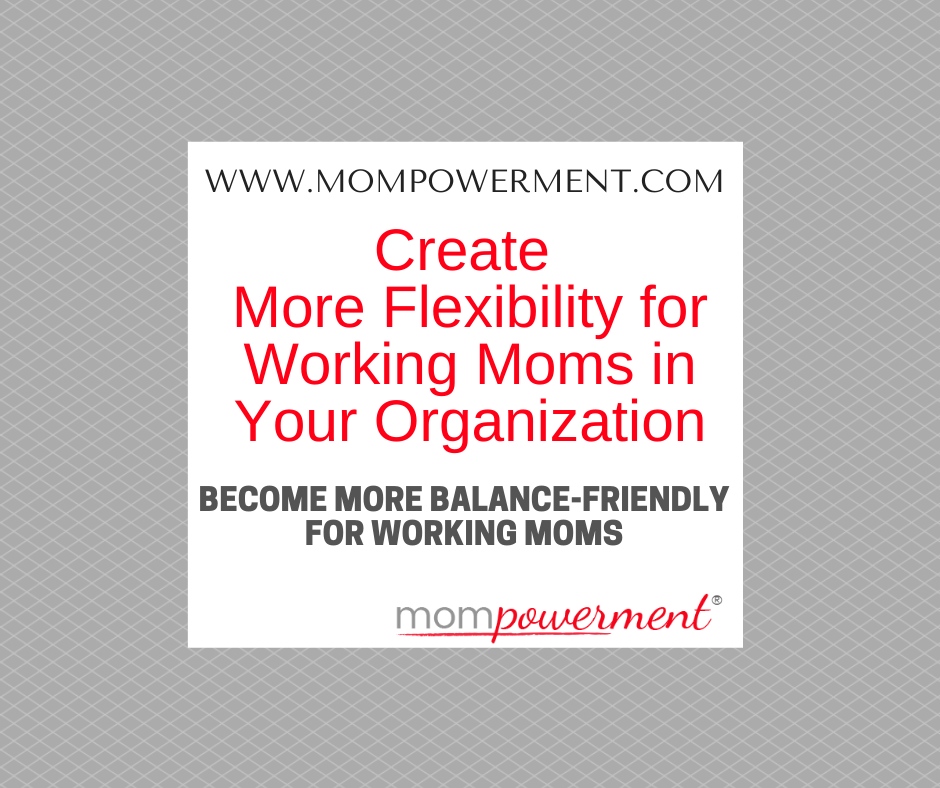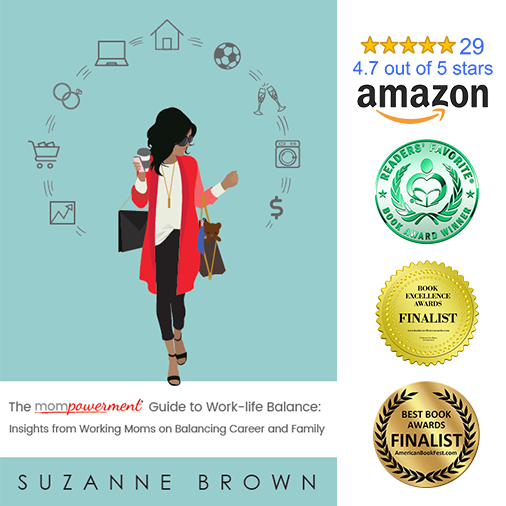
As a follow-up to a recent video I did on LinkedIn, I’m expanding on what flexibility can look like. Flexibility can take a lot of different forms. In this first of a 4-part series for employers this month, I’m sharing ideas for how you as a company can integrate flexibility into all sorts of different aspects of what you provide to employees. Let’s get started on how to create more flexibility for working moms in your organization.
How many employees are we talking about?
Working mothers account for about one-third of women. With women usually at about half your employees, you’re talking about a sixth of your employees. Yes, this directly impacts almost 20 percent of your employees. When you consider caregivers, that number is one in four of all female employees, so your total number affected by caregiving duties is important. And then consider what this looks like when you add working dads. You get the idea!
What’s in it for you to be more balance-friendly?
On top of it being the right thing to do for your employees, it makes business sense to be more balance-friendly. I’ve got a whole blog on why it makes business sense to be balance-friendly, but let me summarize here:
- It impacts your bottom line. Companies with women in 30 percent of leadership roles, see a financial benefit versus their competitors that don’t.
- Turnover is expensive. In a normal year it usually costs 50-200 percent to find, recruit, train, and get someone new up to speed when you lose an employee. Consider the elevated cost of and longer timeframe to find talent during the Great Realignment – let’s stop calling it’s the Great Resignation.
- Diversity attracts diversity. Working moms and women in general want to see themselves reflected in senior leaders and managers so they know they too can reach those heights and still be supported by senior management and peers.
- Diverse teams help with customer perspective. With more diverse teams, you’re more likely accurately reflect your customer base and create products and services that they will buy. This is even more the case if mothers and working mothers make the buying decision about your product.
Why do working moms need flexibility?
During the pandemic, working moms have needed more flexibility to deal with school closings and kids getting Covid. Families have relied on moms to deal with these challenges. The need for flexibility to address these hasn’t gone away.
Schools or daycares might close because of too many Covid cases and/or a lack of substitutes. (The number of substitutes is down for some school districts and childcare facilities.) Don’t forget many cities and/or states make kids quarantine because of exposure to a positive Covid case. (As you add new remote employees, take the differences in how other cities and states deal with positive cases as you create new (or temporary) policies.)
As masks come off, the usual childhood illnesses pop up again (I’m looking at you, Flu A and Flu B, Strep, tummy bugs, etc.). On top of the pandemic, parents will start dealing with the usual situations of kids home sick with these and the situations where mom rushes to school because her child broke his/her arm on the playground. So, it’s Covid challenges plus the usual motherhood adventures.
And these same challenges can affect aging parents. The same working mom who acts as the primary care provider for her kids is likely to have to care for her aging parents and maybe even parents-in-law.
And then there are the typical tasks of life like getting a repairman to deal with the washer on the fritz. Don’t expect these to happen on a weekend.
Working moms want to be able to head out unexpectedly when family emergencies come up. They want to be able to work from home on teacher workdays. Making each of these circumstances require negotiation with a manager is unnecessary and inefficient for all involved.
I’ve spent a lot of time setting the stage. Let’s move on to what flexibility can look like, shall we?
Remote work
Chances are that during the pandemic you shifted to employees working remotely wherever that made sense for your company. As of September 2021 a Gallop poll shares that about two-thirds of white-collar roles are remote at least some of the time. There is the chance that this will continue to be the case with all the surges in Covid cases around the US. It’s great that you made this change. If you’re one of the companies that feels you must shift back to the office environment, it might be time to reassess your plan. A Gallop poll in early summer 2021 indicated that more than ninety percent of employees who can do their job remotely would like to work from home at least some of the time. Yes, more than ninety percent.
Besides, employees who work from home are more productive than those in the office. And you want your employees to be efficient and effective, right?
This is one type of flexibility with limited costs. Sure, you might need to pay for a new chair or a printer (remember that they can always take items home from the office if they’re not being used). Chances are, though, that you can do this for a very low cost if any.
Let employees work when and how they need to
If there has ever been a moment for flexibility to allow people to work when and how they need to, this is that moment. Period. If you don’t need your employees at specific meetings, the focus should be on people completing their work when it’s due, not on tracking every last minute they are at their desks. You have more important things to do as a manager, HR professional, or senior leader.
So, what does this look like? It could mean a shift in hours (e.g., 7-3 or 10-6) or simply giving the space and the time throughout the day to work a total of 40 hours over the course of a week.
Should it matter if that working mom or dad is visibly available online all day as long as he or she responds to work communications, whether internally or externally, in a reasonable time (hint: agree to what this period of time is ahead of time). Does it make a difference if Mary or John turns in whatever needs to be done at 3 pm or 8 pm as long as it’s in whoever’s inbox needs to touch it next by tomorrow morning? Should you be measuring results more and butts in seats less? Chances are the answer is yes.
Flexibility requires trust, which hopefully you have since you hired the employee. And it requires an understanding of the bigger picture. Does when and how people work matter as long as there are doing a good job and meeting deadlines? If so, why do you care when and how they work? Have faith in your team to get the work done efficiently and effectively.
And here’s the beauty of this as a new part of your culture. It should cost pretty much nothing to implement. There isn’t a cost to adding this kind of flexibility.

Does every role have to be full-time?
Does every job in your company have to be full-time, usually 40+ hours? Is it possible to have some part-time roles where employees are still engaged and making things happen in their careers (e.g., not on the mommy track)? Can you create job shares so that two people can take the place of one? These less than 40+ hour/week roles can attract incredibly high caliber candidates, who simply can’t or don’t want to work full-time. It could be the opportunity to bring back working mothers to your organization.
And remember that not wanting to work full-time doesn’t mean an employee isn’t engaged or excited about his/her career. It could be a result of the pandemic or the desire to spend more time with young children. If the latter is the case, he/she might be interested in working full time again in the not-so-distant future.
For working mothers coming back from maternity leave, having a limited ramp with part-time hours that ramp up over several weeks could help as they get back into the work-life groove. It can make the whole return to work post-maternity leave more manageable and more likely. As educated women have their first child later, they might not return after maternity leave. They might not feel the need financially or the desire -and might sit out of the professional world for a few years.
This moment is also a great opportunity for job share. Two people essentially work together to fulfill the workload of one person. This could entice working moms to return to the workforce, even with the challenges of the pandemic.
Depending on how this works, it might or might not have additional costs, especially in the case of jobshare. So, how does that additional cost compare to the cost of finding new talent if it means you could bring working moms who have left your company back to your workforce.
Learn What Employees Need
Before you start to implement what you think employees want or need, take time to ask them directly. Use a variety of different feedback options, including anonymous surveys, physical boxes where people can turn in filled-out surveys. Give managers training so they can ask key questions in a variety of different ways. This is one of those moments when Employee Resource Groups (ERGs) are helpful.
Don’t Forget about Working Dads
Yes, the focus of my work is on helping become more balance-friendly for working moms and on helping working moms create greater balance. One thing that will help working mothers in your organization is to ensure these different work options, benefits, etc. also apply to working dads. Things are changing and working dads also need to have access to resources to be more engaged as a parent. Don’t assume a family has a more traditional care arrangement where mom is the primary caregiver. In fact, you can help working moms share home responsibilities and the mental load. (Don’t forget that Mompowerment provides workshops on these types of topics.)
There you have it. Several ideas on how to create more flexibility for working moms in your organization. You’ve now got a more developed definition of flexibility to consider for the working moms (and dads) in your organization. As you read this, don’t feel you must take on all these initiatives or all of them at once. See what works for your specific needs. Take time to understand what you need now versus down the road. How will you create flexibility for working moms in your organization? What areas do you need help with?
Don’t feel overwhelmed by everything I share here. Mompowerment can help you create more flexibility for working moms in your organization Email me directly with questions or for more information about consulting. In the meantime, don’t forget to download the Mompowerment white paper on how to Become a More Balance-friendly Company for Working Mothers.


